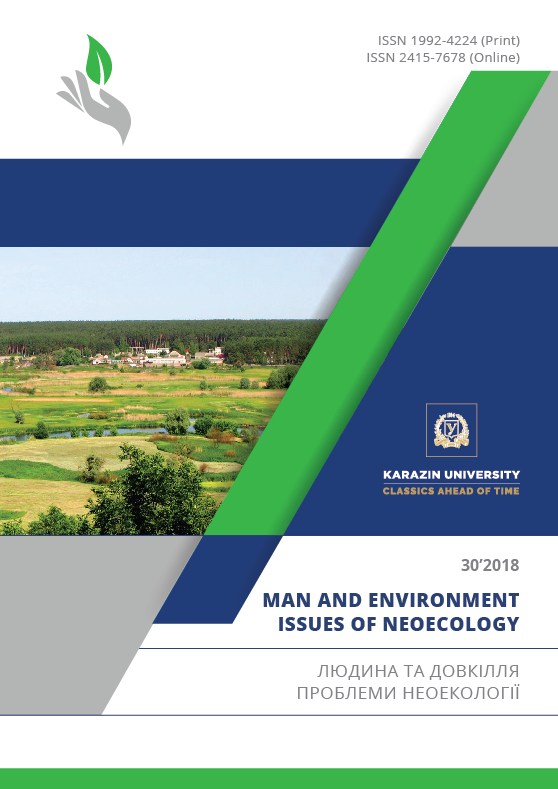Comparative Environmental Assessment of Wind Energy Projects: Acoustic Load
Abstract
Purpose. Comparative environmental assessment of wind energy projects from the perspective of the potential acoustic load on the environment: compliance with permissible values, specificity of propagation and optimization of siting. Methods. Analysis and synthesis of information, field research, cartographic and mathematical modelling. Results. In the most part of the study area, the background noise level reached rather high values, higher than the «comfort» level of 45 dB. The simulation of sound propagation from the wind turbine showed an attenuation to a value of less than 20 dB at a distance of 2 kilometers. The resulting acoustic load was calculated for the points referring to the buildings of the nearest settlements (for the case of installing the Enercon E-40 and Enercon E-115 wind turbines). The calculations of the resulting sound levels make it possible to state that the acoustic effect of the wind turbines in both siting strategies is 15-20 dB lower compared to the background noise level, the main component of which is wind noise. The excess of noise level was 5 dB for Enercon E-115, and 8-9 dB for Enercon E-40. Conclusions. According to the type of wind turbine, the noise level may overlap with the background level and produce a relatively less acoustic impact on the local population. Even in case of the extensive wind energy development strategy, the total noise levels will not exceed the background levels within the model site.
Downloads
References
Beranek, L. L. (1988) Acoustical Measurements. New York: Acoustical Society of America, 841 [in English]
Vasilyev, Yu. S., Khrisanov, N. I. (1991) Ekologiya ispolzovaniya vozobnovlyayushchikhsya energoistochnikov [Ecology of using renewable energy sources]. Leningrad: Publishing House of the Leningrad University, 343 [in Russian]
Tretyakov, О. S., Volkovaia, O. O. (2013) Zastosuvannia HIS pry rozrobtsi stratehii rozvytku vitroenerhetyky na rivni administratyvnoho raionu [Application of GIS in designing wind energy development strategy at administrative district level]. Problems of Continuous Geographical Education and Cartography. Kharkiv: V. N. Karazin Kharkiv National University 17, 9–12. [in Ukrainian]
Ryzhenkov, M. A., Ermolenko, B. V., Ermolenko, G. V. (2011) Ekologicheskiye aspekty vetroenergetiki [Environmental aspects of wind energy]. Teploenergetika, (1), 72–79 [in Russian]
DSTU 31296.1:2007 «Shum. Opys, vymiriuvannia i otsinka shumu na mistsevosti» [Noise. Description, measurement and assessment of noise in the area] [in Ukraininan]
GOST 23337-78 «Shum. Metody izmereniya shuma na selitebnoy territorii i v pomeshcheniyakh zhilykh i obshchestvennykh zdaniy» [Noise. Methods for measuring noise in residential areas and in residential and public buildings] [in Russian]
Clausen, N-E. (2013). Planning and development of wind farms: Environmental impact and grid connection. DTU Wind Energy. DTU Wind Energy I, (46) [in English]
IEC 61400-11 2002-12 «Wind Turbine Generator Systems — Part 11: Acoustic Noise Measurement Techniques». [in English]
Rogers, A. L., Manwell, J. F., Wright, S. (2006) Wind Turbine Acoustic Noise. Amherst: Renewable Energy Research Laboratory, 26 [in English]
Tretyakov, О. S., Volkovaia, O. O. (2014) Geoinformational support of wind power development at the local level. Problems of Continuous Geographical Education and Cartography. Kharkiv: V. N. Karazin Kharkiv National University, 19, 117–120 [in English].
Authors reserve the right of attribution for the submitted manuscript, while transferring to the Journal the right to publish the article under the Creative Commons Attribution License 4.0 International (CC BY 4.0). This license allows free distribution of the published work under the condition of proper attribution of the original authors and the initial publication source (i.e. the Journal)
Authors have the right to enter into separate agreements for additional non-exclusive distribution of the work in the form it was published in the Journal (such as publishing the article on the institutional website or as a part of a monograph), provided the original publication in this Journal is properly referenced
The Journal allows and encourages online publication of the manuscripts (such as on personal web pages), even when such a manuscript is still under editorial consideration, since it allows for a productive scientific discussion and better citation dynamics (see The Effect of Open Access).





